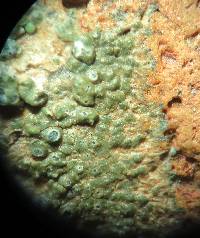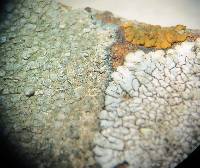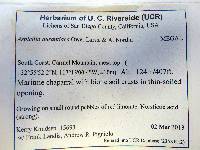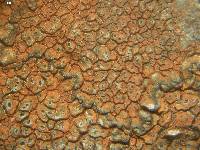
Consortium of Lichen Herbaria
- building a Global Consortium of Bryophytes and Lichens as keystones of cryptobiotic communities -
- Home
- Search
- Images
- Species Checklists
- US States: O-Z >
- US National Parks
- Central America
- South America
- US National Parks
- Southern Subpolar Region
|
|
|
|
Family: Megasporaceae
|
Nash, T.H., Ryan, B.D., Gries, C., Bungartz, F., (eds.) 2007. Lichen Flora of the Greater Sonoran Desert Region. Vol 3. Thallus: areolate, sometimes rimose at the edge, (1-)2-7(-11) cm in diam., (0.1-)0.2-0.6(-1.5) mm thick areoles: angular, rarely rounded, flat, sometimes concave, rarely convex or irregular, rather often fertile, (0.2-)0.4-1.0(-1.6) mm in diam., contiguous, rarely dispersed prothallus: usually narrow, sometimes rather wide, forming a zone at the thallus edge, sometimes fimbriate or fringed, black to gray-black or blue-black to blue-green, 0.1-0.7(-2) mm wide surface: orange to orange-red or orange-brown to red-brown, usually with an ±olive tinge (especially in the centre of the areole and the thallus), sometimes gray-brown to brown (then often with an orange tinge at some part of the thallus), rarely yellow-orange; orange parts of the thallus usually dull, olive to brown parts ±shiny upper cortex: (20-)30-40(-50) µm thick, uppermost part brown, sometimes ±green, 5-15(-20) µm thick, with cells 5-7(-8) µm in diam.; cortex covered with an epinecral layer (2-)10-20(-30) µm thick, in the upper part usually with ±orange to red crystals photobiont: chlorococcoid, cells ±round, 5-20 µm Apothecia: aspicilioid, scattered to numerous, (0.1-)0.2-0.4(-0.6) mm in diam., 1-2(-4) per areole, round, sometimes angular to irregular or elongated disc: black, but usually with a dense white pruina, concave to rarely flat thalline margin: thin, usually flat, sometimes slightly elevated, usually forming a white rim around the disc exciple: I- to partly I+ blue, rarely completely I+ blue, (20-)30-50(-70) µm; uppermost cells brown to olive-brown, ±globose, 5-6(-7) µm in diam. epihymenium: green (rarely blue-green) to olive (sometimes very dark) or olive-brown to rarely brown, with crystals, N+ blue-green to sometimes green, K+ brown to green-brown hymenium: hyaline, I+ persistently blue, (130-)160-200(-230) µm tall paraphyses: submoniliform to moniliform, with (1-)2-4(-5) upper cells ±globose or somewhat cylindrical, uppermost cell (3-)4-5 µm wide, in lower part (1.5-)2 µm wide, slightly branched and anastomosing subhymenium and hypothecium: pale, I± persistently blue, together (20-)40-70(-80) µm thick asci: clavate, (70-)80-140 x (20-)24-40 µm, (6-)8-spored ascospores: hyaline, simple, ellipsoid, (17-)19-29(-33) x (11-)12-19 µm Pycnidia: rather often present, 1-2(-4) per areole, immersed, often with a white rim, up to 220 µm in diam., with a black, punctiform to rarely elongated ostiole, 50-120 µm in diam. conidia: short, filiform, (5-)6-10(-13) x (0.6-)0.8-1(-1.5) µm Spot tests: medulla I-, K+ red, P+ orange, C-; rarely K+ yellow, P+ orange or K-, P- Secondary metabolites: norstictic acid and hyposalazinic acid (chemotype 1, most common); stictic acid, hypostictic acid and hyposalazinic acid (chemotype 2; Knudsen 2553; Owe-Larsson 9084, both from Torrey Pines State Park, San Diego Co., CA); norstictic acid, stictic acid and hyposalazinic acid (chemotype 3; Hasse 2436; Nash III 29614-a, 29632; Wetmore 63623); occasionally with only norstictic acid (Knudsen 385) or without secondary substances (Owe-Larsson 8870, 8873:a; Weber & Santesson). Substrate and ecology: on ±exposed, siliceous small stones on the ground in desert areas or chaparral, sometimes on boulders or rocky outcrops, often growing with Dimelaena World and Sonoran distribution: southern California, Baja California and Baja California Sur, at 20-670 m, mainly below 150 m. Notes: Aspicilia aurantiaca is a conspicuous lichen usually having an orange to orange-red thallus with an olive tinge, small, white-pruinose apothecia, a tall hymenium, large spores, short filiform conidia and usually a K+ red thallus (commonly with norstictic acid and hyposalazinic acid, but several chemotypes exist). Unpublished DNA studies (4 specimens tested, including the type: Owe-Larsson 8802, 8814, 8816, 8870) show that the variation in thallus color, from orange to olive or brown, is clearly within the species variation. These studies also indicate that A. aurantiaca is closely related to but well distingushed from A. pacifica and A. santamonicae, which both differs in thallus color and by having longer conidia. Another species with the combination norstictic acid and short conidia is Aspicilia intermutans (Nyl.) Arnold, a European species common in the Mediterranean Region. According to the original description it differs from A. aurantiaca with respect to the gray thallus color and the longer and thinner spores (23-34 x 9-15 µm). |
|
|
|
Powered by Symbiota

























